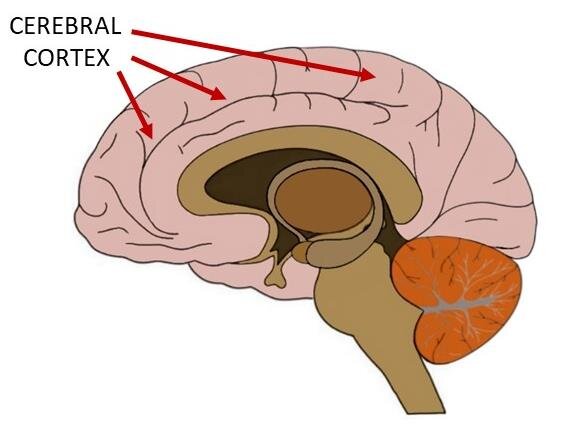Know Your Brain: Cerebral Cortex
Where is the cerebral cortex?

Cortex means "bark" in Latin and appropriately the cerebral cortex is the outermost layer of the brain, made up primarily of grey matter. It is the most prominent visible feature of the human brain, and although it is only a few millimeters thick, it comprises about half of the weight of the brain. The surface of the cerebral cortex is extensively folded, forming ridges called gyri and valleys called sulci. The folding allows for the surface area of the cerebral cortex to be increased significantly, making room for more neurons. The cerebral cortex is separated into two cerebral hemispheres by a large sulcus called the medial longitudinal fissure.
What is the cerebral cortex and what does it do?
The cerebral cortex forms extensive connections with subcortical areas, and thus it is involved in multitudinous brain functions. As a means of simplification, the cerebral cortex is often characterized as being made up of three types of areas: sensory, motor, and association areas.
Sensory areas receive information related to sensation, and different areas of the cortex specialize in processing information from different sense modalities. For example, the primary somatosensory cortex is located in a strip of cortex called the postcentral gyrus. It receives information from the body about tactile sensations as well as touch-related sensations like pain and temperature. Other areas of the cortex are devoted to processing information related to olfaction, hearing, vision, taste, and the vestibular senses.
The motor areas of the cerebral cortex are involved in the initiation of movement. Motor areas are primarily found in the frontal lobe, and include the primary motor cortex, premotor cortex, and supplementary motor cortex. The primary motor cortex gives rise to many of the fibers that make up the corticospinal tract, which is the main pathway for voluntary movement in mammals. The premotor and supplementary motor cortices have important roles in movement as well, but their exact contributions are not very well understood.
While sensory and motor areas both obviously play an indispensable role in healthy cognition and behavior, association areas are also extraordinarily important. Association areas are spread throughout the cortex and are involved in the integration of information from multiple brain regions. This integration can add complexity to the perception attained with one sense modality, or it can facilitate complex cognitive processes like language, artistic creation, and decision-making.
When an association area is involved in integrating information from one specific sense modality it is called a unimodal association area. An example can be seen in the visual association cortex, which surrounds the primary visual cortex. While the primary visual cortex is responsible for processing visual information related to the basic aspects of an image (e.g., size and shape), the visual association cortex is involved in more complex aspects of that image, such as using the disparity in information sent from the right and left eyes to perceive depth.
Other association areas integrate information from multiple sense modalities--along with information from other areas--and play a role in high-level cognitive functions; they are called multimodal association areas. For example, the posterior parietal cortex contains association areas that receive information from a number of different sense modalities. Among the functions the posterior parietal cortex seems to be responsible for is the ability to construct cognitive maps of one's environment and of one's own body. When this faculty is disrupted due to damage to the parietal lobe (such as from a stroke), patients may develop a unique syndrome where they fail to pay attention to one fraction of their visual field (usually the side of the body opposite from the cerebral hemisphere where the stroke occurred). This is called contralateral neglect, and it can be severe enough that the individual neglects to eat the food from one side of his plate, doesn't use proper hygiene (e.g., shaving, brushing teeth) on one half of his body, or even refuses to acknowledge that limbs on one side of his body are really his own.
This combination of sensory, motor, and association areas accounts for the majority of human cognition and behavior. Thus, the cerebral cortex is essential to healthy brain function, and the relatively recent evolution of this structure is sometimes pointed to as the most significant event in the evolution of the human brain.
Reference:
Nolte J. The Human Brain: An Introduction to its Functional Anatomy. 6th ed. Philadelphia, PA. Elsevier; 2009.


